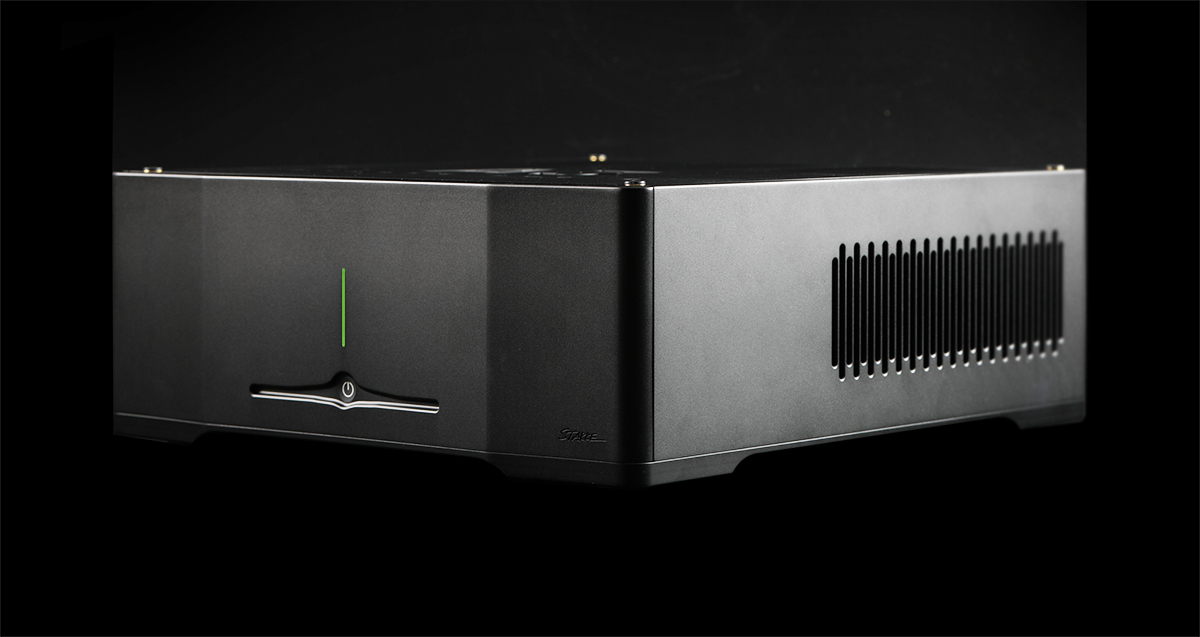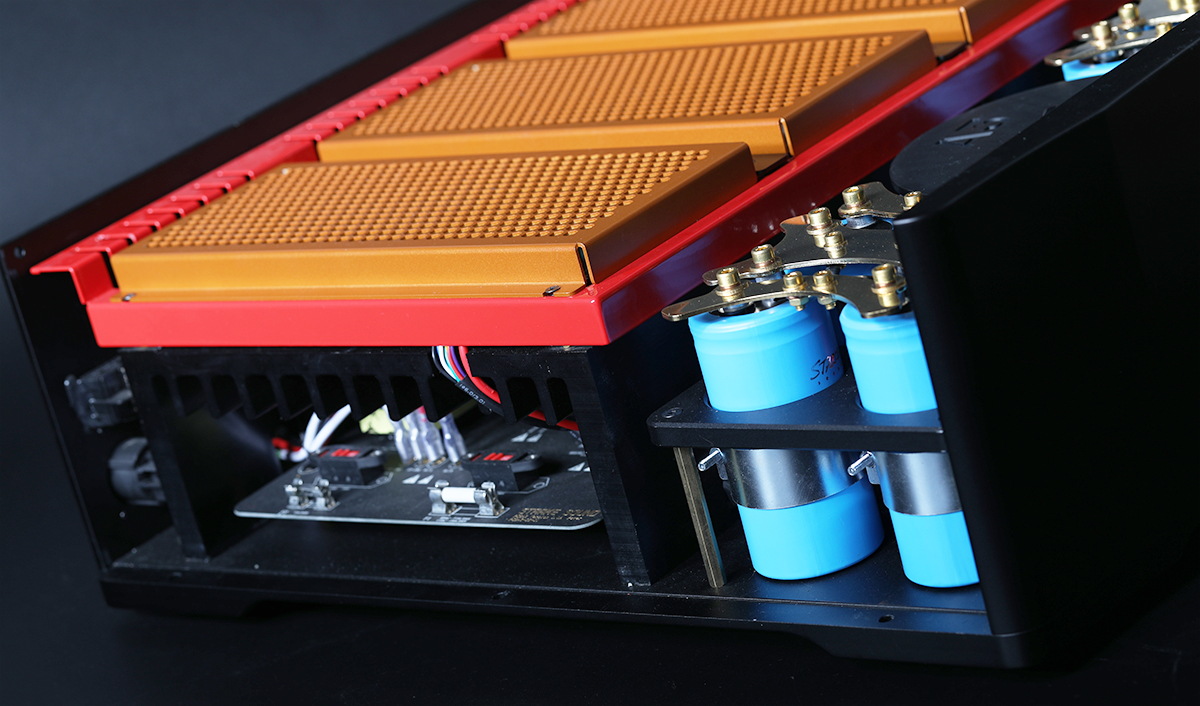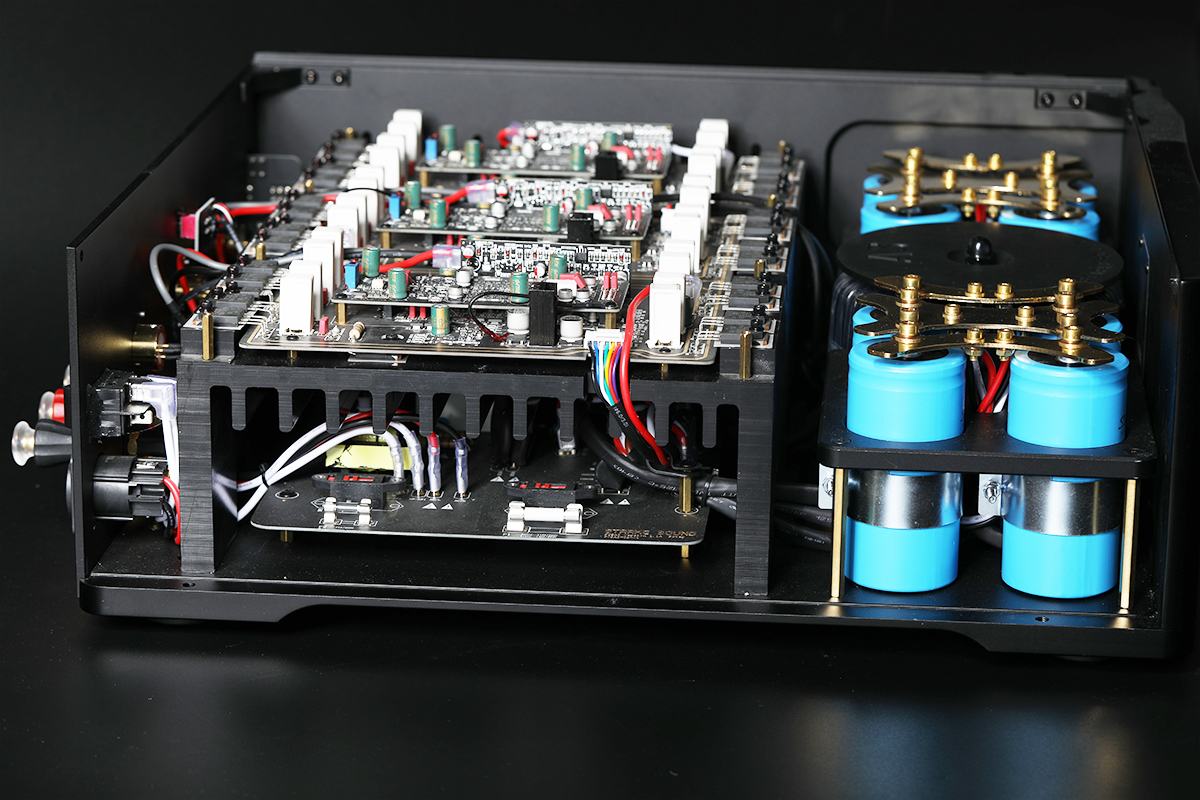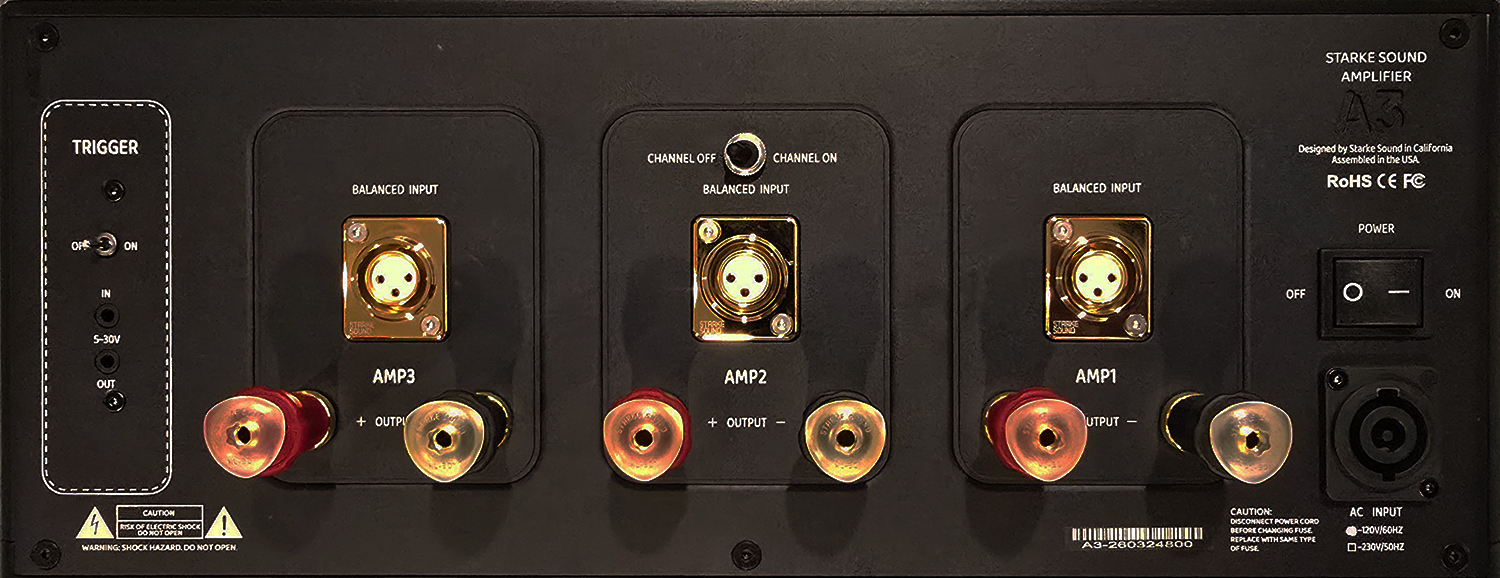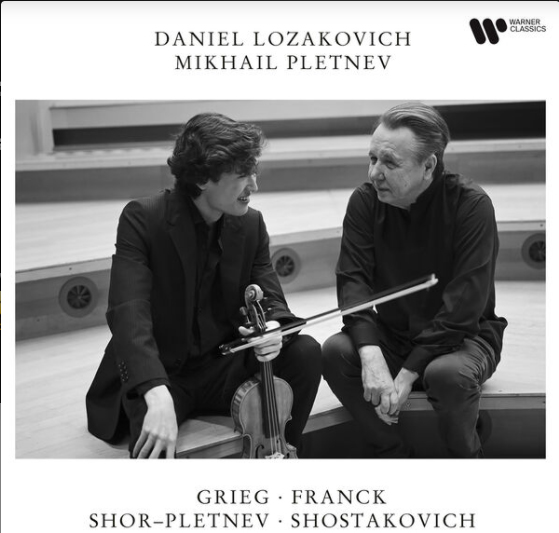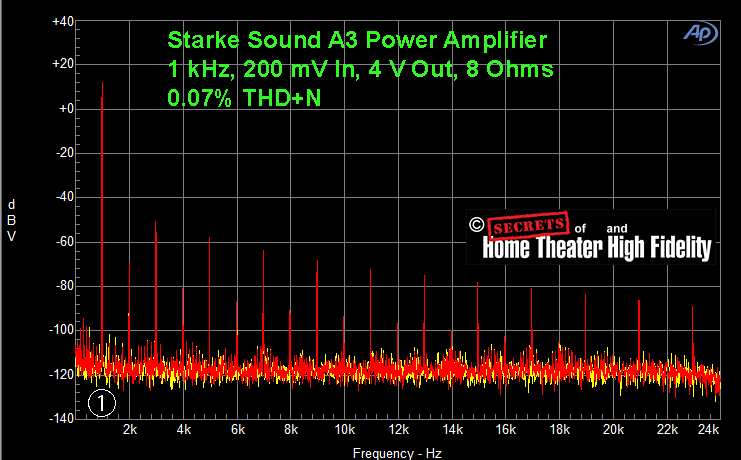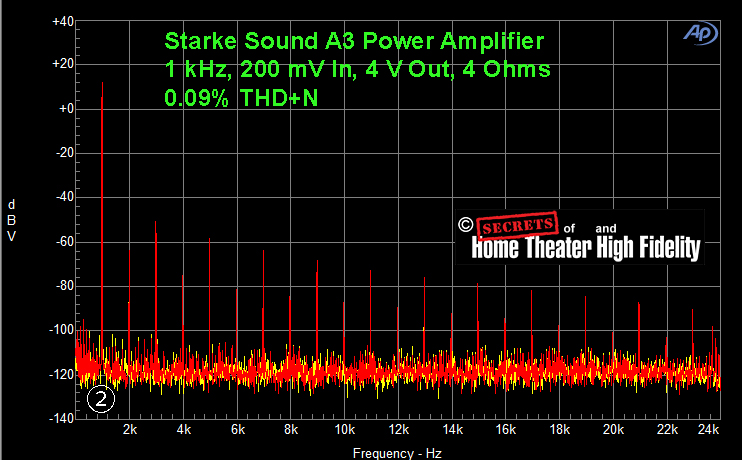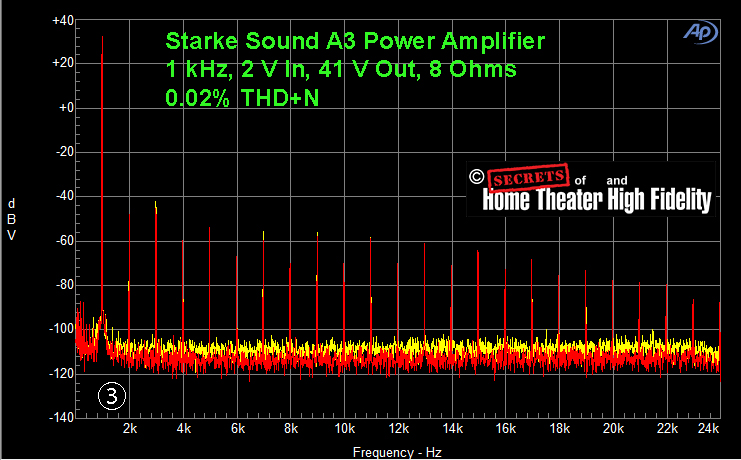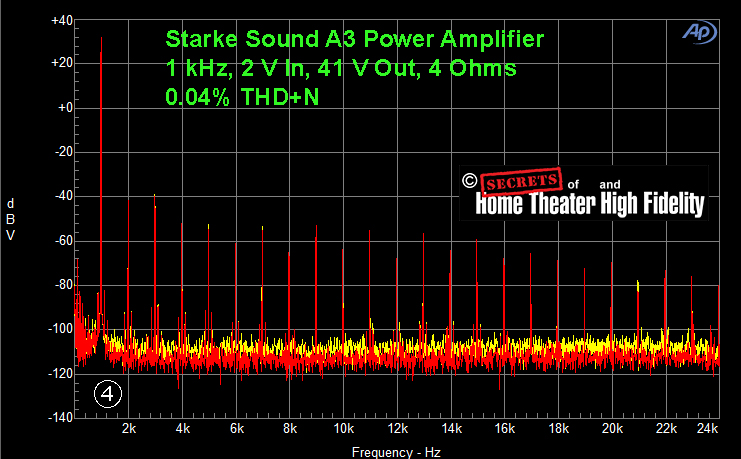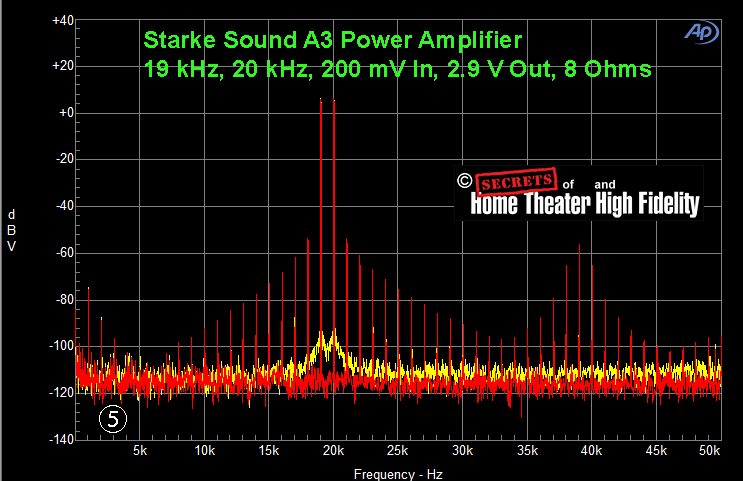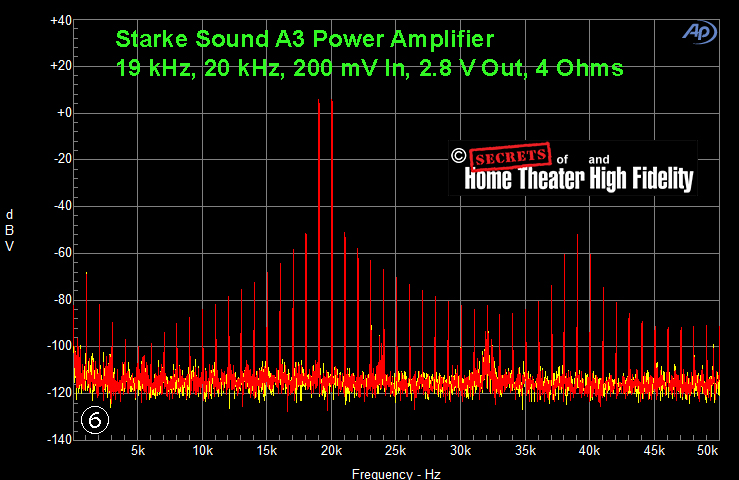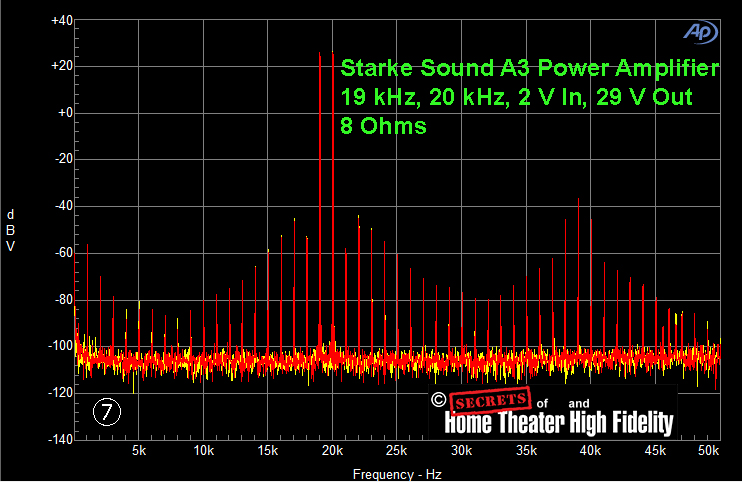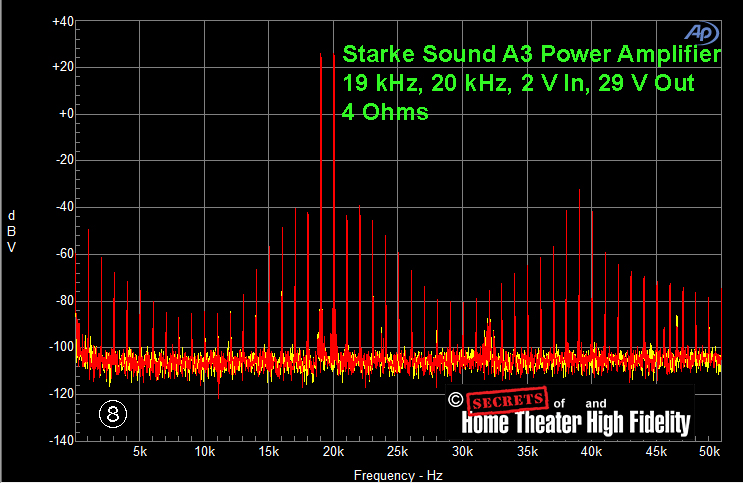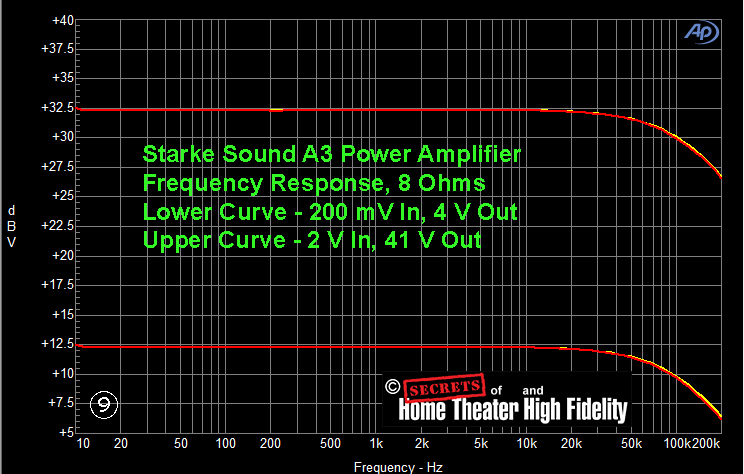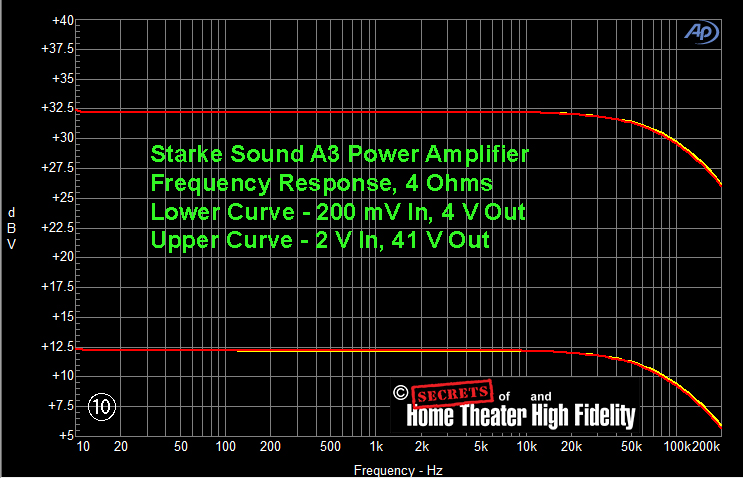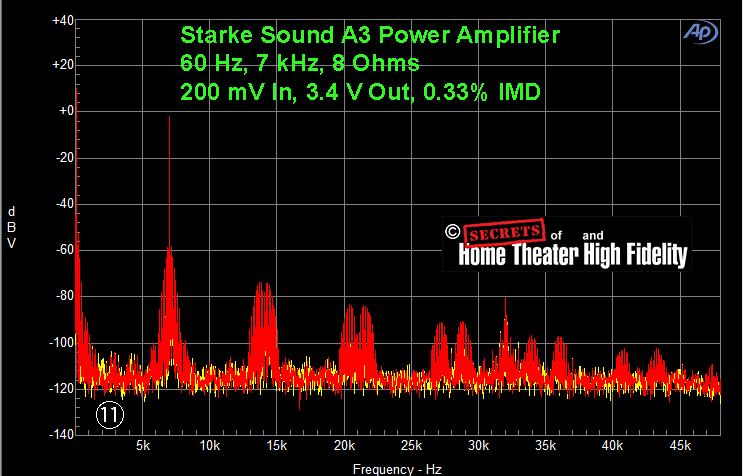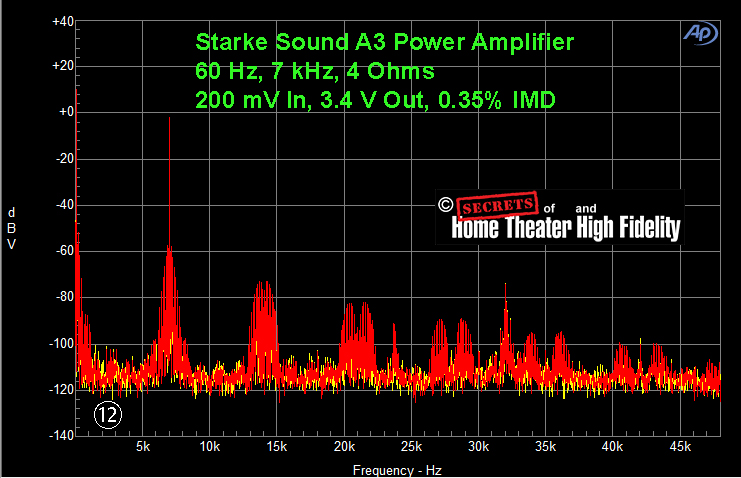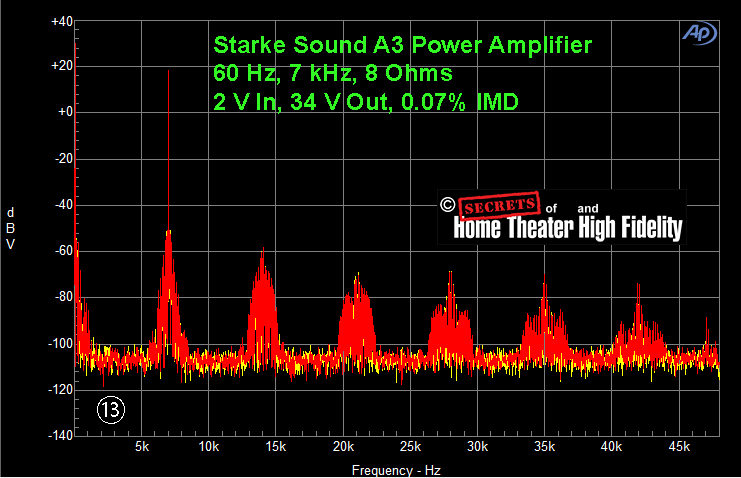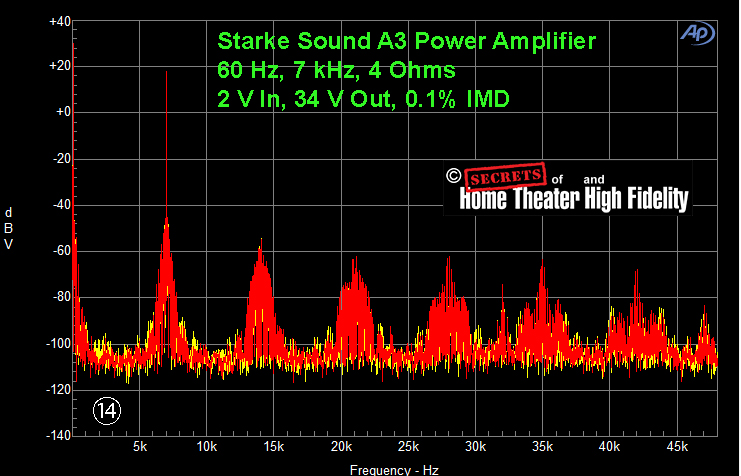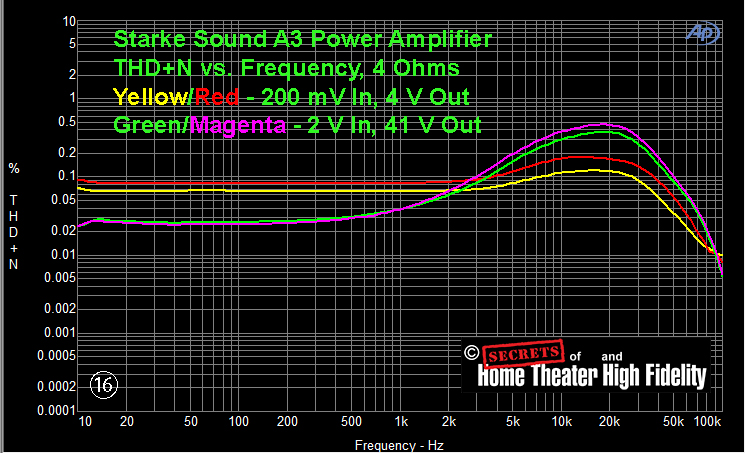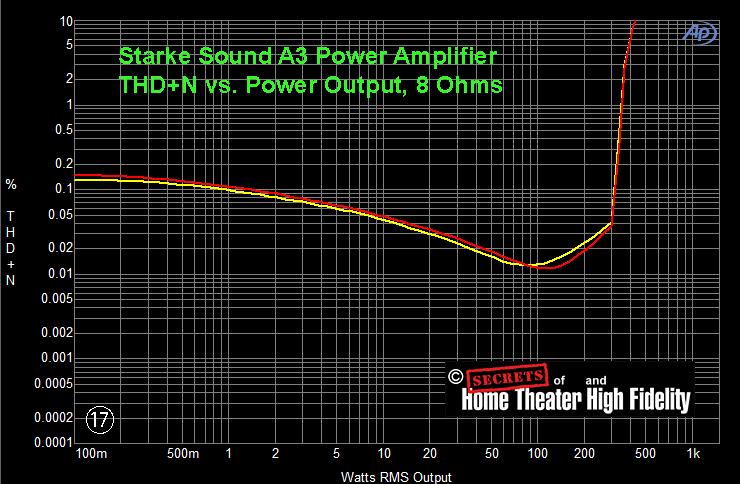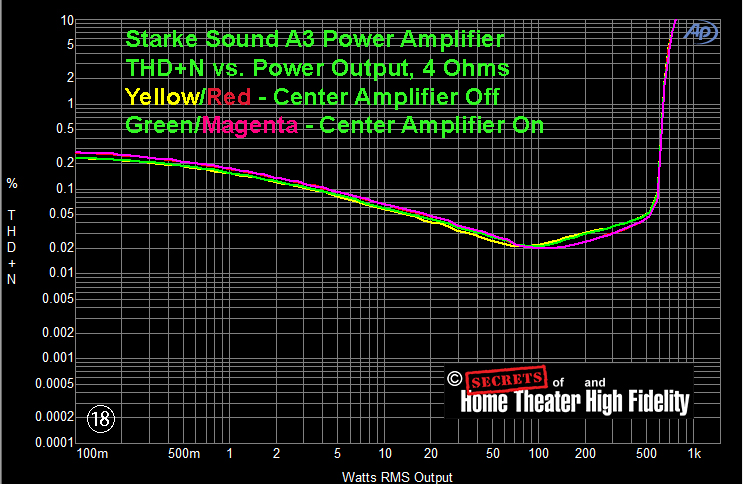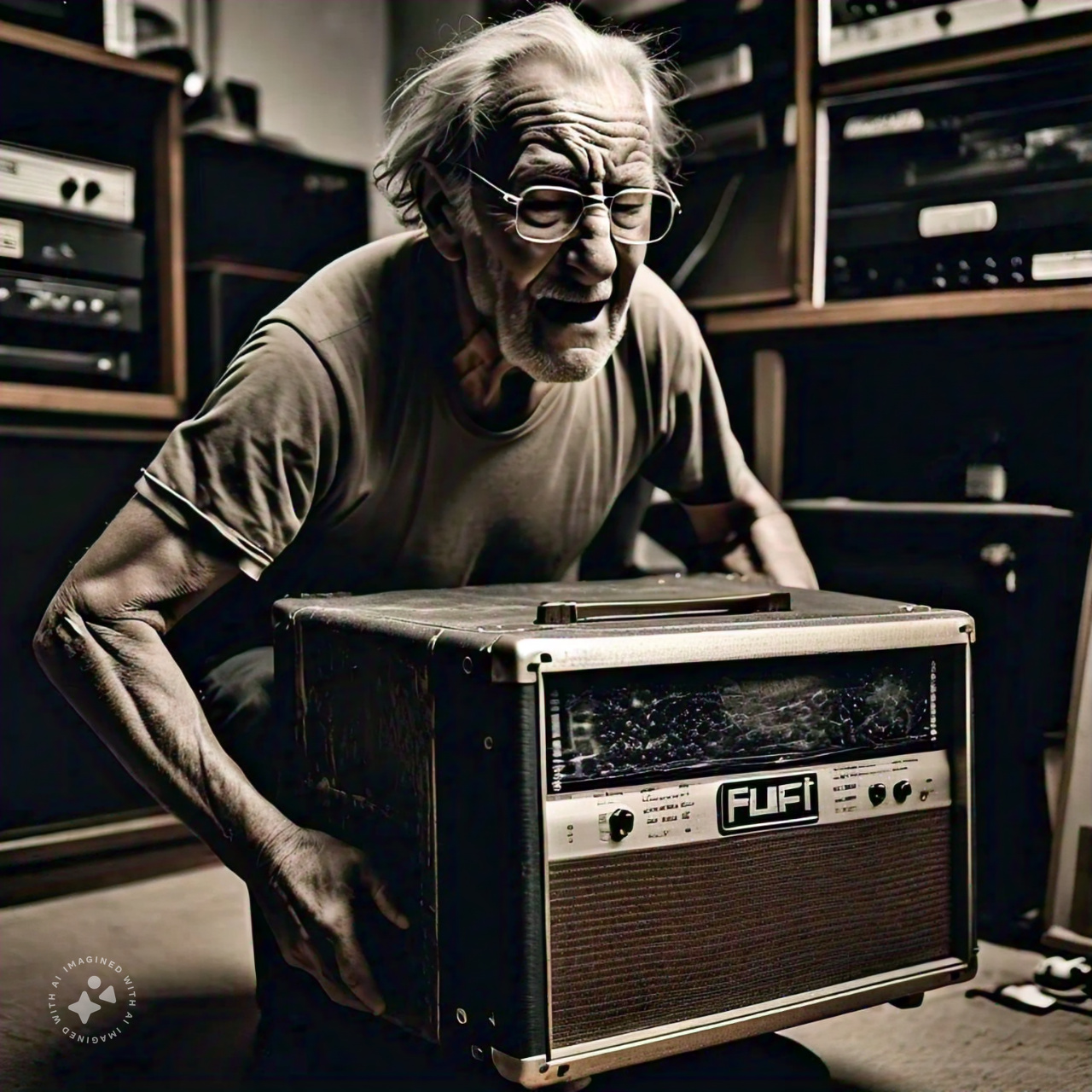I obtained their model A3, which is a three-channel Class A/B design. It outputs 50 Watts per channel in Class A and the rest, up to 620 Watts per channel into 4 Ohms. Did it accomplish that? Read on.
Starke Sound A3 Three-Channel Class A/B Power Amplifier Highlights
- Very powerful
- 50 Watts Class A
- 80,000 µF power supply capacitance
Starke Sound was founded in 2009 in Los Angeles. They started out designing speakers and became interested in home theater technology. They now market not only speakers but several multi-channel power amplifiers. The A3 is their top-of-the-line amplifier, and it has three high-power channels. I mean VERY high power.
NUMBER OF CHANNELS:
Three
CLASS:
Class A to 50 Watts, Class A/B to maximum output
POWER OUTPUT:
320 W RMS at 8 ohms 1% THD
300 W RMS at 8 ohms 0.1% THD
620 W RMS at 4 ohms 1% THD
580 W RMS at 4 ohms 0.1% THD
800 W RMS at 2 ohms 1% THD
FREQUENCY RESPONSE:
5Hz to 50 kHz (+0/-1 dB)
10Hz to 20 kHz (+0/-0.1 dB)
DISTORTION:
0.002% THD, 10 Watts, 4 Ohms
INPUTS:
Three XLR
INPUT IMPEDANCE:
20 kOhms XLR
INPUT SENSITIVITY:
2.5 Volts
OUTPUT IMPEDANCE:
0.1 Ohm, 5 Hz – 50 kHz
MAXIMUM OUTPUT VOLTAGE:
± 90 Volts
DIMENSIONS:
7″ H x 17.3″ W x 21.3″ D
177.8 mm H x 440 mm W x 540 mm D
WEIGHT:
83.6 Pounds
MSRP:
$6,900 USD
Website:
Company:
SECRETS Tags:
Starke Sound, A3, Three-Channel, Class A/B, Power Amplifier
Secrets Sponsor
The A3 is a three-channel amplifier. It delivers 50 Watts per channel Class A with all three channels operating and 620 Watts per channel into 4 Ohms Class A/B.
This is a very powerful design. The chassis contains 80,000 µF of capacitance. Each channel has its own cover, as shown in the figure below.
There is no space to spare inside. You can see the capacitor bank on the right. The A3 has 26 dB of gain. There are six gain stages: three for pre+ signal handling (input stage) and three for amplifying. The A3 has fully balanced bipolar transistor schematics; every channel has thirty pairs of input stage transistors, five pairs for medium power, and five pairs of high-power output stage transistors.
The rear panel has three XLR balanced inputs (gold-plated) and three sets of binding posts. There are no RCA single-ended inputs. On the left is a panel for setting up triggers to turn the amplifier on and other components, too, if you wish; the AC power input is on the right. It uses a twist-and-lock Speakon-type connector, not a conventional AC connection, so you have to use the included special power cable. It is massive and very heavy. I found out why after my circuit breaker popped during 4-ohm bench testing. I had to get a higher current power strip before I could continue.
A toggle switch on the rear turns on the power and goes into standby. Press a button on the front panel to turn it full-on for listening.
Here is the power cable. Very high current capability. At 620 Watts into 4 Ohms, it can suck the wall dry.
I listened to the Starke Sound A3 Power Amplifier using an Oppo BDP-105 Disc Player with music files stored on a hard drive attached to the player via USB, Qobuz streaming from a laptop to the USB-B input on the player, Pass Labs Xs Preamplifier, and MartinLogan CLX Electrostatic Speakers. The cables were Clarus and Wireworld.
Below is a graphic with my standard test albums. I always use some of these for listening tests.
I also listened to several new releases, such as the following, which were released in August 2024.
Violins are very difficult to reproduce without harshness. The Starke Sound A3 played them with just the right amount of edge to project them into the room. It became obvious to me that Starke built in a certain amount of harmonic distortion to present sound with a specific “flavor.” It stays within a narrow range regardless of the power.
The album below, a new one, had violins playing in their middle range. The sound was silky and relaxing.
Anne Meyers’ violin music, on the other hand, has sounds in the stratosphere. In her album, Mirror in Mirror (a standard album), the notes are so high, that they are almost inaudible, especially the soft way she plays them. The A3 presented her music without any audible harmonic overtones at all. Just the natural harmonics of her instrument wafted into the room. My electrostatic speakers are very sensitive to the tendency of an amplifier to deliver “edgy” transients. That is because the diaphragm between the stators is so lightweight. The A3 didn’t sound that way, even with the very strident multi-string chords that Anne plays in some of this album’s tracks. Igor Stravinsky (1882 – 1971) would have liked this amplifier.
The album shown below has electronic music and contains some very short-duration sounds. They can be very intense. The A3 delivered these without distracting additional distortion (electronic music is rife with distortion of its own). An amplifier that has considerable amounts of THD would make music like this unlistenable.
Himmelrand (see the standard test album graphic at the beginning of this section) has complex organ sounds, and the A3 was up to the task. It dealt with all the notes distinguished and put out deep bass without strain.
The voices in a choir (standard test album – Sacred Treasures of Venice) remained separate and distinguishable.
Copland’s Fanfare for the Common Man is another standard test album for me, and the Telarc version is the best one. It is a power test, and the A3 is more than capable. Cymbals, bass drums, and trumpets sounded glorious.
My favorite standard album is Art Pepper Meets the Rhythm Section. I listen for any overly intense edge transients and false tonality. There was none of this when powered by the A3.
Lute music (Gesualdo – standard album) yielded such realistic plucks, I would never be able to hear these in an actual concert because the lutist would be too far away from my seat.
Secrets Sponsor
The Starke Sound A3 Power Amplifier is very unusual and in a good way. Regardless of the output, distortion remained within a narrow window.
In Figure 1 below, 1 kHz, 200 mV In, 4 Volts Out, 8 Ohms load, THD+N was 0.07%.
With the same parameters except for the load being 4 Ohms, distortion was 0.09% (Figure 2).
With a 41 Volt output into 8 Ohms, THD+N was 0.02%. This is what surprised me. I expected distortion to go up, not down.
With a 4 Ohm load, distortion was still low, at 0.04% (Figure 4).
Below in Figure 5, we see 19 kHz and 20 kHz test signals into 8 Ohms with a 2.9 Volt output. There are several side-peaks.
At 4 Ohms (Figure 6), there are two more peaks on either side compared to the 8 Ohms load shown above in Figure 5.
With the output being 29 Volts (Figure 7), there are the same number of side peaks as in Figure 5 where the output was 2.9 Volts. There is some overlap with peaks at 7 kHz with peaks below that region.
At 4 Ohms (Figure 7), the side-peaks look very similar to 8 Ohms (Figure 8).
Frequency Response at 8 Ohms is shown below in Figure 9. It is slightly flatter at the higher output. It is usually the other way around. Unusual.
With a 4 Ohm load, the response is just a bit flatter at the lower output voltage. There is usually more of a difference.
IMD (Intermodulation Distortion) results, using 60 Hz and 7 kHz sine waves at a 4:1 ratio, are shown in the following 4 figures.
In Figure 11, 200 mV in, 3.4 Volt out, 8 Ohm load, IMD was 0.33%. Notice that as the number of sine waves input increases above 1, the output voltage decreases from what it was using a single sine wave. This is a standard finding with all amplifiers.
Figure 12 shows the results with a 4-ohm load. IMD went up a bit to 0.35%.
IMD decreased to 0.07% with 2 Volts in and 34 Volts out and an 8 Ohm load (Figure 13).
At 4 Ohms, there was a large difference compared to 8 Ohms, with the high output voltage. IMD was 0.1%. That’s still pretty good for 144 Watts.
Figures 15 and 16 show THD+N vs. Frequency at 8 Ohms (Figure 15) and 4 Ohms (Figure 16). Distortion is similar at frequencies below 5 kHz for both loads, but at higher frequencies, 4 Ohms produces somewhat more distortion, but it remains within reasonable levels (0.3%).
Power output with an 8 Ohm load is shown in Figure 17. The knee is at 300 Watts and 0.04%, and it is 1% at 350 Watts.
At 4 Ohms (Figure 18), the knee is at 500 Watts, 0.05% THD+N) and 620 Watts at 1% THD+N. So, this amplifier puts out a heck of a lot of power, and it meets its specifications. For this test (Figure 18), I tested the output with and without the center channel power amplifier switched on. There was no difference in the maximum sustained power output. I suspect that impulse power output would be different, but I cannot test that.
Starke Sound’s A3 Three-channel Power Amplifier is remarkable. It would make a great choice for a stereo system and home theater setup by using two channels for stereo music listening and all three channels for front left, front right, and center channels when watching movies. It contains distortion in a narrow range throughout its power output capability. Make sure your equipment rack can handle the weight.
- Massive power output
- Distortion is well-controlled
- Ideal for combined use as stereo and left, right, and center for home theater
- Hernia repair insurance from lifting it




